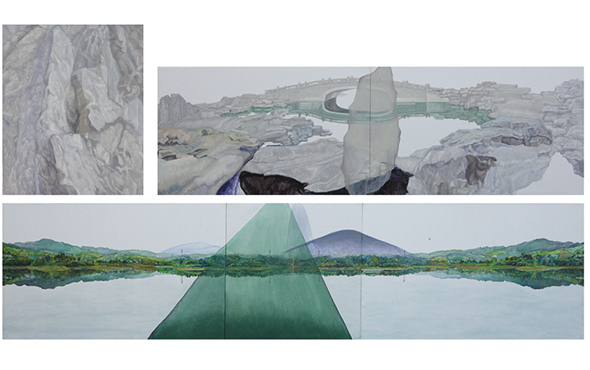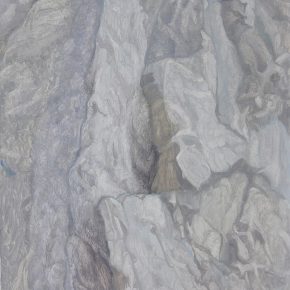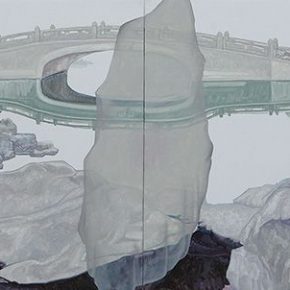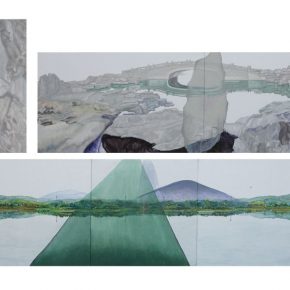
From Wang Chenxu’s graduation works including “Get Out of the Mountain” and “Get Into the Stone”, I see a balanced and light interlaced experience which is rational and emotional which might be related to one of the contradictory Libras who are in pursuit of perfection.
Interview Time: May 26, 2017
Interviewee: Chen Lin (hereinafter referred to as Chen)
Interviewer: Zhong Yuwei (hereinafter referred to as CAFA ART INFO)
Editor: Lin Jiabin
Translated by Chen Peihua and edited by Sue/CAFA ART INFO
“Finally, I would like to say that I was grateful for the opportunity to study in CAFA after high school. I am so lucky to study in CAFA and to study painting. Fortunately, painting can be a lifetime activity which is excellent.”
–Wang Chenxu
First of all, my work is an expression of the care of Chinese landscape, which is a real emotional sustenance and a literary expression. What is this really, how do you truly face the landscape in front of you, truly face the inner feelings, and truly face the canvas and the screen. “Get Out of the Mountain” is an initial exploration of this “truh”. On the other hand, I am also thankful ss I learned how to use the traditional method of painting to express contemporary or contemporary tastes in my creation. “Get Out of the Mountain” is a presentation of the new relationship between my viewing and expression, and also a presentation of the thoughts of the “text” replaced by the “picture”.
CAFA ART INFO: Did you specifically create this set of work for graduation? Why did you choose Chinese-style scenery and Chinese-style observation as your creative theme?Wang: This “Chinese-style” is actually one of my emotional starting points and my emotional source. I had some thoughts on the identity and cultural context when I was in Europe last year. When I faced such a landscape, my state and emotions were real, and it was actually the thing that really touched me, and the reason why I painted this theme.
CAFA ART INFO: I learned from your information that you majored in oil painting, while your works use the language of oil painting to reveal a Chinese-style landscape. Would you like to talk about your creative inspiration?
Wang: If there is a connection between my work and traditional Chinese painting, I think I demonstrate emotion. I often use oil painting for my creations because I have been fascinated by the canvas, the process of starting from the first brush stroke on the canvas to the ultimate fulfillment is very magical.
“Get Into the Stone” is the second piece in this series, the triptych is a progressive presentation of the problem that I am thinking of. The stone presented in the “Get Into the Stone” is the stone of the Jingxinzhai in Beihai Park, the stones in the northern gardens are different from the ones in the south, which are very dry, naked and direct, and this direct emotion is hidden in a subtle context, which is very interesting for me. I am looking for a direct feeling which is not strong.
“A Stone” and “Get Into the Stone” is a group, which is an extraction of the elements of “Get Into the Stone”, and a viewing from the microcosmic perspective, from the overall to the partial, the change in the way of viewing brings changes in emotion and mood.
CAFA ART INFO: How do you balance the subtle and direct elements in your picture? Or how do you balance your Chinese content and Western languages in the picture?Wang: I especially like the word of balance, and I am indeed trying to find a balance in the picture. I painted it thinly, and only once, because a lot of white space remains and I need the effect with thin brush strokes, so the fault brush strokes can’t be covered or erased. I use a special way to balance and convey the mood which might be subtle, but the style of painting is very direct, and I want to retain the most original feelings.
It is through the distant mountains and the close stones a connection between the changes of the way of viewing and the expression to some extent. Whether you see it or not, a line that is similar to the horizon runs through them and links the pictures, directing it so that it can be extended indefinitely. In addition, the work is based on real feelings, and this emotion comes from the appeal of the scene, while it is also my desire and pursuit of the ideal on other shores.
CAFA ART INFO: I read the faint sense of contradiction in your picture, but it is certainly not the solo answer. Every viewer has his own opinion. What do you want to convey through your work?Wang: Because I am a tangled Libra, haw-haw and the contradiction has always been there, so it is important to deal with it. Rather than using works to express some things, it is an emotional output for me and I use the painting to speak. In the interpretation of the work, it reads that it is actually a virtual horizon, because you will never get that line, you can only see it, and it is a guide for you to go on.
CAFA ART INFO: Did the experience of studying abroad have any influence on your graduation creation during your stay in Zurich in 2016?Wang: It did impact on my work, but is not directly reflected on the screen. It was a valuable time for me that I could escape from the original state and examine myself, which was also the task for me to study abroad. When they asked me about the work, it forced me to finish my own ideas, to establish my own system, and this process was very important, so I can continue to sort out the own direction and focus, which is helpful for the later creations. You can’t be greedy in bringing many things into one picture, and one painting only focuses on one thing in order to speak clearly, so I basically have been refining my art in terms of the picture.
CAFA ART INFO: Will you continue to create? Will you continue this style? Do you have a goal?Wang: This style will continue, but it might stop one day. For my goal, I hope to paint a large number of paintings, but I have to understand it before I draw, so the workload is a problem.
Photo courtesy of the artist

































